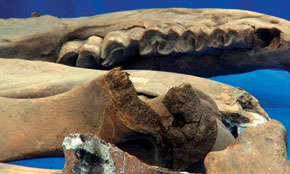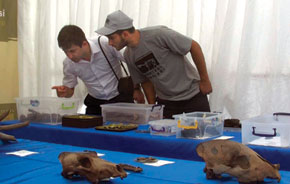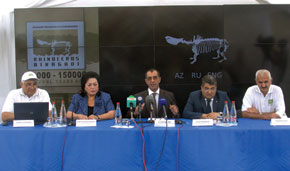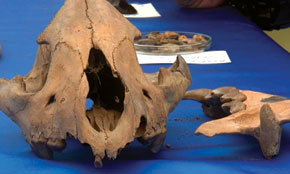 Who could imagine the bustling, modern Baku inhabited by the fauna of an African savannah? Sounds strange? But it seems it was once true of this area. Giant cave hyenas, bigger than today’s lions; wolves and huge rhinos with five-foot tusks; large porcupines; deer; primitive bulls - all of these and many other animals, even elephants, once lived on the land now occupied by Azerbaijan’s capital. It is difficult to believe, but it has been confirmed and research continues in the Binagadi area of Baku. There are plans to turn the site into a museum similar to the world famous Rancho La Brea Tar Pits in Los Angeles.
Who could imagine the bustling, modern Baku inhabited by the fauna of an African savannah? Sounds strange? But it seems it was once true of this area. Giant cave hyenas, bigger than today’s lions; wolves and huge rhinos with five-foot tusks; large porcupines; deer; primitive bulls - all of these and many other animals, even elephants, once lived on the land now occupied by Azerbaijan’s capital. It is difficult to believe, but it has been confirmed and research continues in the Binagadi area of Baku. There are plans to turn the site into a museum similar to the world famous Rancho La Brea Tar Pits in Los Angeles. That was 50,000 years ago…
The remains of the hyenas and rhinos uncovered by archaeologists are estimated to be 50,000 years old. For this unique discovery the scientists must thank the oil and bitumen deposits that have preserved flora and fauna in the area in almost perfect condition. The clay, water and oil content of the earth found at the archaeological site provided protection from adverse elements in the environment.
Excavations have established that there was a water and oil mix very close to the surface. Similar bituminous lakes exist in other parts of Asia, North and South America but, as the Azerbaijani scientists noted, the chemical properties of Caspian oil are uniquely suited to the preservation of a variety of organic and inorganic substances.
According to the archaeologists there was, earlier in history, a freshwater lake in Binagadi onto whose shores seeped Balakhani oil. Reaching the surface, the oil was oxidized to form bitumen and this trapped animals approaching the watering hole, burying them in a viscous mass. Thus, one such trap revealed 10 ancient rhinoceros skulls. In all the former lake, originally fresh water but later filled with natural asphalt, contained more than 100,000 bones.
First excavations
The history of the study of fossil vertebrate animals in Azerbaijan dates back to the second half of the 19th century. Since then there have been two extensive research expeditions. The first began in 1938 under the leadership of Ragimbek Jafarov and was continued by scientist V.Bogachev; thousands of animal and plant remains were excavated, including many vertebrate bones.
An important contribution to the study of vertebrate fauna in Azerbaijan was made by labourers extracting bitumen from a lake to repair house roofs. They suddenly came across the gigantic bones of an unknown animal and informed the local authorities. Subsequent excavations revealed the remains of prehistoric animals. In 1942 a second expedition began under the leadership of N. Burchak-Abramovich and continued until 1954. Tariel Eybatov, Director of the Zardabi Natural History Museum of the National Academy of Sciences’ Institute of Geology told us that several collections of fauna and flora were amassed by Soviet scientists who afterwards took away almost all the valuable finds and other materials.
No excavations had been conducted in Binagadi since 1954. No research was carried out on the finds and almost everything that had been retrieved was removed by the scientists who had been invited here to work. It seemed that everything had been forgotten. Local archaeologists have only recently begun to uncover remains. We do not have specimens of molluscs, birds, insects and some flora. We are now trying to find them too.
The Elephant Age in Baku
Tariel Eybatov tells us that the third expedition has started and detailed studies during excavation have made it possible to reconstruct the world of animals and plants on the post-Pleistocene Absheron peninsula and to trace the processes of evolution. All the evidence discovered, including the skeletons of large hyenas, wolves, rhinos, bulls, deer, etc. indicates that the climate was very cold at that time, but the abundant vegetation provided enough food, even for huge animals. For example, he says, elephants are also believed to have lived here. In the search for data to identify species modern methods help to create more accurate diagnoses, including the determination of age of specimens.
It’s interesting that the chemical composition of one of the rhinoceros bones is 45,000 years old. And we have established that remains of juniper and vine are from 55,000 years ago. We use complex methods to determine the exact age of these samples of fauna and flora. Animal remains accumulated here over quite a long period and detailed studies will give us a more complete picture.
Mr Eybatov is very confident that the site in Binagadi will soon be recognised internationally. It has been a boon for the country’s archaeologists and they expect it to become Azerbaijan’s Rancho La Brea.
It is a rare occurrence for scientists to find a small area with such a high concentration of research material. Only Rancho La Brea compares to this site. The main difference is in age. Binagadi is estimated to be about 200,000 years old whereas Rancho La Brea goes back 60,000 years old. There are also differences in the species found.
Baku’s Rancho La Brea
The Rancho La Brea Tar Pits in Los Angeles, California are widely regarded as some of the world’s richest sources of mammal fossils. Some 60 different species have been identified there, including the sabre-tooth tiger, bear, lion, wolf, camel, bison and mastodon. Seventeen human bones, including a pelvis and a skull, have also been found, as well as a number of artefacts such as milling stones and bone hairpins. The conventional explanation for the abundance and diversity of fossil material is that successive episodes of animal entrapment created an ever-increasing mass of bones at the bottom of tar pools. An unwary horse, for example, might step into an apparently normal pool of water to drink. Becoming ensnared in the tar beneath the surface, its cries of distress would attract hungry carnivores, such as wolves, seeking an easy meal. These carnivores would themselves slip and fall into the pool, becoming, like their prey, inescapably trapped.
Mr Eybatov told us that further explorations are planned, as is the construction of a museum of 1,500 hectares at the Binagadi site, along the lines of La Brea.
Future tourists will not only view rare exhibits of prehistoric animals, they will also be able to follow the scientific processes involved in the research. Of course, it will be quite an expensive project, but the initial draft has already been prepared.
Ancient antlers
We were interested to know about the most ancient animal remains to be found in Binagadi. It turns out that the antlers of a giant deer are thought to be the oldest remains recovered from the bitumen. They are more than 200,000 years old; the archaeologists are trying to recreate a complete image of this giant animal.
The scientists are also asked whether people inhabited the area in that era. Rich animal life: horses, oxen, deer and others, was indispensable to human survival and the discovery of vertebrate fossils shows that primitive people could have lived on the Absheron peninsula in the Palaeolithic Age. But this is a question for further study by Mr Eybatov and his colleagues.





